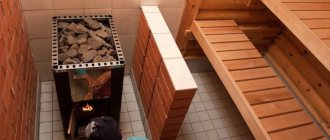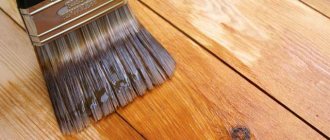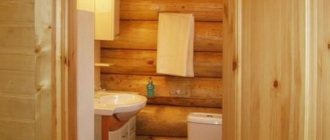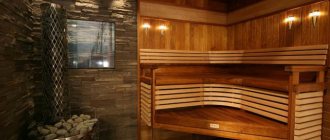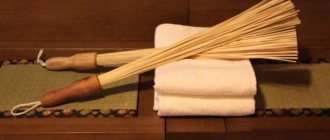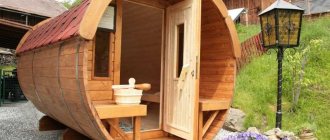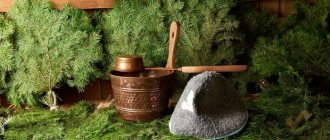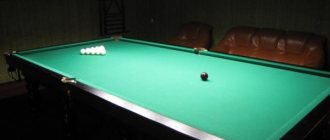Lining is one of the most popular materials for finishing baths and saunas. Natural wooden slats fit organically into the interior, maintaining environmental friendliness and a unique cozy atmosphere of the room. They look aesthetically pleasing and attractive, are easy to install and last a long time. In addition, wooden materials promote good air exchange, fill the room with a pleasant forest aroma and have healing properties.
But over time, the lining without proper care begins to darken and loses its attractive appearance. This occurs due to regular exposure to humidity, water and temperature changes. In addition, when using brooms, especially oak brooms, drops and splashes, which include tannins, fall on wooden surfaces. These elements cause natural wood to darken and turn black.
Soot and soot are integral elements when heating and using a bathhouse or sauna. They settle and gradually accumulate on the walls, floor and ceiling, on bath furniture and window sills. As a result, the materials lose their presentable appearance. Among other things, wood absorbs various fats and dirt, which causes dark spots on surfaces. In this article we will look at how to clean the lining in a bathhouse from soot, blackening and dirt.
Special means
In the store today you can find many different products specifically designed for removing soot from wooden surfaces.
These can be either chemicals or sponges pre-impregnated with such substances. Chemical sponges can be easily purchased at a hardware store. They are impregnated with a substance that can dissolve soot. The principle of operation using such sponges is very simple. You just need to move them along a contaminated wooden surface, making quick movements directed from top to bottom.
But the problem is that such sponges are disposable. Just a few movements on the surface are enough, and they will already become dirty. Therefore, you need to purchase several sponges at once to ensure that you have enough. And after using sponges, it is important not to forget to wash the surface with plain water.
Safe recipes
In order not to damage the wood either by mechanical or chemical influence, or in the case of a small amount of “resin”, use the following means to get rid of resin on the boards:
- 25 g of wood or any liquid soap mixed with 50 ml of ammonia and 1 liter of hot water;
- acetic solution of concentrated acid and water in a ratio of 1:50.
Important! The latter remedy is also good for removing alkali residues after using any other substance or solution in order to get rid of resin on boards. It helps a lot, including when you are washing finished walls and you need to remove cleaning residue from the joints of the crowns.
Mechanical method
The wooden surface of the bathhouse can be cleaned manually using sharp scrapers or similar tools. You need to scrape off soot deposits very carefully, working through every centimeter, so this method requires serious effort and a lot of time. An alternative option would be to clean the soot after each new heating of the bath using hard brushes so that the deposit does not penetrate deep into the wood. Both options take a lot of time and effort with low efficiency and the danger of damaging the wood.
You can make the process easier by using a grinding machine, but after using it, the dust is washed off with soapy water, which is not very convenient and the result does not always meet expectations. During this treatment, only the upper part of the soot deposit is removed, but the smell remains. The disadvantages of this method include a high risk of damage to the wooden surface of the bathhouse and scratches that spoil the appearance of the wood.
Chemical compositions for removing soot deposits quickly and efficiently remove dirt from the wooden surface of the bathhouse, pushing them out.
The advantages of the chemical composition include high efficiency, the absence of harmful elements and toxins, economical consumption, as well as ease of application and safe use.
It is recommended that you carefully study the instructions before using the chemical composition and adhere to them when working with the chemical. Application time varies depending on the composition and manufacturer. If chemical compounds come into contact with the skin or mucous membrane of the eyes, rinse the affected areas with plenty of water and consult a specialist.
What not to use
It is not recommended to use classic brushes for cleaning wooden surfaces. After this treatment, dirt and soot will be absorbed even more. In addition, the brush can damage the top layer of the lining.
It is also recommended to clean the lining using traditional methods and means. Soot and soot after treatment with vinegar, ammonia and other similar compounds become viscous. As a result, it is even more difficult to wash off the blackness. In extreme cases, you can use a soap solution or dishwashing detergent diluted in water. However, they will not be able to remove heavy stains and are more suitable for preventative washing.
Do not use powders or abrasives, otherwise they will scratch the surface. This will not only spoil the appearance of the products. Moisture and harmful bacteria will begin to accumulate in cracks and scratches, which will soon destroy the wood.
Mechanical method
As for chemical compounds, they usually just need to be applied to the surface, wait for a while, and then rinse off. You must act according to the instructions. Most of these products contain alkali, which quickly removes soot without having a negative effect on the structure of the wood.
Special cleaners are usually a colorless liquid and are sold in cans. An example of such a chemical is Mazbit. It is water based.
Also used to combat soot are the products “BZ-20”, “Chist-Dezo”, “Facade Cleaner No. 2”. All of them are quite effective. They are not sold everywhere. However, such soot neutralizers can be obtained at specialized retail outlets without any problems.
How to remove soot from walls and ceilings in a bathhouse
MAZBIT PLUS - Concentrated product designed to clean surfaces from the effects of fire
.
Designed for effective quick cleaning of any surfaces: general construction materials: wood, concrete, plaster, stone, tiles from various contaminations by combustion products: soot, soot, carbon deposits.
More details
However, during operation, a wooden bathhouse can cause some difficulties, one of which is soot deposition.
In addition to the fact that it looks very unaesthetic and dirty, such deposits can also be harmful to health, since in large accumulations they tend to release carcinogenic substances.
Therefore, at the first sign of them, you should take care of how to wash soot from a tree in a bathhouse.
Soot deposits on walls and ceilings are removed in a few steps. Be sure to cover the floor with cellophane, and it is recommended to seal the joints with tape so that the removed soot does not soak into the floor. Plaque can be removed with a vacuum cleaner or a dry broom using jerky movements, and then treat the walls and ceiling with a specially impregnated sponge.
The chemical composition is left on the surface for a specified period of time in accordance with the manufacturer’s recommendations, and then washed off with warm water along with any remaining soot and soot. If necessary, repeat the procedure. After completing the treatment, allow the surface to dry thoroughly.
How to clean the lining
- To clean the lining in the steam room and in the bath, take a sponge and a dry cloth, a container with clean water, a special product, a broom or vacuum cleaner, and plastic film. To clean ceilings and walls, you can use a mop with a soft cloth or sponge. Which mop is best to choose for your home, see here;
- First, clean the surface to be treated with a vacuum cleaner or broom;
- Prepare cleaning solution according to instructions;
- Apply the prepared composition to the darkened surface and thoroughly wipe the product with a sponge;
- After cleaning, rinse off the applied composition and any remaining product with plenty of water. During the process, cover the floor with film to prevent further contamination of the surface. After all, all the dirt drains down. Wash the floor last;
- Finally, be sure to wipe the paneling with a dry cloth. Otherwise, the raw wood will begin to rot.
Instructions: problems and their solutions
Under the influence of moisture, temperature changes and other factors, wooden surfaces inside the bathhouse lose their original appearance. Lack of proper care leads to the proliferation of microorganisms and mold, and steaming in such a bathhouse is unpleasant. Therefore, all structural elements require care and cleaning, for which special products are used. The compositions help eliminate blackening, mold, and prevent cracking of wooden furniture.
Maintenance and cleaning maintain the aesthetics of the bathhouse
A common problem is the appearance of mold and mildew on the walls and wooden surfaces of the bathhouse. The reasons for their occurrence are high indoor humidity, lack of ventilation and condensation, frequent use, improper ventilation or poor insulation. As a result, mold and mildew appear, which looks like a white-grayish coating on surfaces and in corners. This leads to poor health and health problems.
Mold often appears in the absence of ventilation
The spread of mold and mildew leads to rotting of the structure. To solve and prevent problems, you need to find the cause. First, regular ventilation of the room in which the mold has occurred is ensured. It is worth drying surfaces in the summer and in dry, hot weather. You should check the functionality of the ventilation and clear it of blockages.
We suggest you read: How to make a folding shelf in a bathhouse
To eliminate mold and mildew, you need to take the following measures:
- clean surfaces from dirt and dust. For processing, you can use folk remedies, for example, alcohol. The liquid accelerates the evaporation of water and penetrates deep into the wood, killing microorganisms. It is worth considering that alcohol is highly flammable;
- for processing, you can use a solution of 1 liter of water, 22 g of iron sulfate, 18 g of table salt and add 44 g of potassium alum;
- Using a sponge and rags soaked in liquid, wipe all surfaces that have become moldy, as well as the area around them;
- processing can be carried out twice. First, mold is removed with a liquid, and then all surfaces are wiped with a new solution and the walls are washed with clean water.
Mold can be removed using professional means. When choosing, you should pay attention to the effect of the composition, as well as the composition. The product should be intended specifically for eliminating fungus and mold, and not for prevention. After processing, drying and eliminating the causes of fungus, surfaces should be regularly washed with preventative agents.
Black traces of soot often appear on wooden surfaces in a bathhouse after heating the stove. This phenomenon can be prevented only by regular cleaning of the chimney and proper operation of the stove. If left untreated, soot penetrates deeply into the wood structure and spoils the appearance of the room.
The boards of the walls and ceiling turn black from soot
Careful organization of the chimney and the area around the stove helps minimize the appearance of dirt. After each heating, fresh soot must be removed, which will preserve the comfort in the bathhouse.
To preserve the appearance of surfaces, you can use the following methods:
- The mechanical cleaning method involves using a scraper or other sharp instrument to remove black deposits from wooden surfaces. A grinding machine is more convenient, but both technologies are labor-intensive and affect the appearance of the walls. With the mechanical cleaning method, the top layer of wood is removed;
- folk methods are different. Often, after each heating, sand or other abrasive substances are used that easily remove fresh soot. Treating surfaces with soapy water is also effective only for fresh dirt;
- chemical removal is the most effective solution. The products that can be purchased in the store contain alkaline components. To use, apply the product with a sponge, let it sit according to the instructions, and then rinse thoroughly. When choosing, it is worth considering the possibility of using chemicals on various surfaces.
Chemical compounds are effective for removing soot from brick, wood, and metal. When processing, be sure to follow the instructions and use rubber gloves.
The appearance of resin on wooden surfaces is typical of pine paneling, flooring or furniture. It is undesirable to use such material in a bathhouse, since at high temperatures resin is released from the structure of the wood. Drips spoil the appearance of surfaces and have a pungent odor.
Pine wood should not be used in a bathhouse
To avoid resin drips, do not use pine wood in the bathhouse. It is best to create the finishing from aspen or linden, cedar, because these materials are safe, aesthetically pleasing and practical to use. If you used pine elements on which streaks appeared, then the problem can be solved mechanically.
A radical method, which consists in completely replacing the pine sheathing with elements made of other wood, allows you to completely solve the problem. Removing the lining requires financial and time costs, but you can avoid the regular appearance of resin.
Removing dirt helps prevent the development of mold, dampness and other unpleasant phenomena. For this purpose, it is necessary to regularly do general cleaning inside the bathhouse. First, you should remove all furniture, rugs and other items from the room. Wash them in soapy water, rinse and dry in the sun. While the furniture is drying, you should clean the inside. This process includes the following points:
- mold, soot and soot, resin are removed using suitable means and methods;
- you need to remove the area from the stove, clean the chimney and the space around the stove;
- all wooden surfaces are treated with antiseptics intended for baths;
- to clean surfaces use a medium-hard brush;
- Special wood bleaches help lighten wood;
- Persistent dirt on the shelves is removed with a grinding machine or sandpaper.
We invite you to familiarize yourself with: Do-it-yourself Japanese Ofuro bath
When cleaning, use only products intended for wood and a simple soap solution. Brushes, sponges and cloth work well with fresh dirt. Absorbed or old stains are removed by sanding or scraping. General cleaning should be done once a month, and after each heating you need to wash the bathhouse.
Processing of lining
Removal of soot, mold and mildew from the lining is carried out using both mechanical and chemical methods. The first category of product involves the use of a grinder or scraper. This affects the appearance of lining surfaces and walls.
Clean walls provide comfort in the bathhouse
Chemicals for bleaching and removing dirt from wooden lining require the right choice. The compositions used must be intended for baths and saunas, which will ensure effective cleaning and safe use of chemicals. Cleaned walls or new lining in a bathhouse can be coated with acrylic paints and varnishes that are suitable for a bathhouse.
Other pollution
Due to the increased humidity in the bathhouse, various contaminations may occur. Since the room is used for washing, shampoos, soaps and other products are used that are quickly absorbed into the wood. In the absence of regular cleaning, an unpleasant soapy layer appears on the surface of walls, furniture and floors.
Every item in the bathhouse requires the removal of soap and dirt.
Metal screws and other elements are inappropriate in the bathhouse, because they will quickly rust from humidity. As a result, rusty marks remain on the lining or other surfaces. They can be easily eliminated using oxalic acid or household chemicals containing this substance. Apply the product to the stains, rub with a sponge, and then rinse the surface well.
Additional Tips
With any method of removing resin, it is advisable to remember and apply useful recommendations . They will help you achieve the desired result, preserve wood material and protect your health:
- When using ready-made solvents, you must wear personal protective equipment (gloves, respirator).
- Chemical cleaning should be done outdoors or in a well-ventilated area.
- If conditions permit, the boards should be exposed to high temperatures. Heating will speed up the release of resin from the wood, and the problem will not recur in the future.
- In some cases, you can get rid of resin deposits on a wooden structure using a blowtorch.
Recipes and tips for removing resin from various surfaces are presented in this section.
Bath insulation
For comfortable operation of the steam room, good insulation of the building is necessary. This allows you to quickly heat the room, steam with convenience and preserve the structure in winter. In the absence of good insulation or the worn-out condition of the building, various problems arise that prevent you from steaming with comfort. In this case, the causes should be eliminated and the bathhouse repaired.
All surfaces of the bath building need insulation
Insulation is carried out for the walls, ceiling, and roof of the bathhouse. For this, only high-quality materials are used, which must be resistant to high humidity. Safety for human health and environmental friendliness of materials are taken into account when choosing.
Discomfort and heat loss in a steam room or dressing room often arise due to insufficient floor insulation. Lack of thermal insulation or air cushion, poor waterproofing, incorrectly selected materials can cause cold air to enter the bathhouse. Therefore, when constructing a building, it is necessary to study insulation technology.
Insulating a wooden floor is very easy
If this problem occurs, the following actions are necessary:
- determining the cause of cold penetration through the floor, for example, lack of waterproofing. Depending on the cause, further actions are taken;
- any cracks and gaps between the walls and floor are sealed using polyurethane foam;
- if the quality of the old insulation is poor, the floor structure is dismantled, and new layers of hydro- and thermal insulation are installed inside, taking into account drainage;
- Cracks in the concrete floor must be sealed with cement mortar, and the drain siphon, which may have cracks, must also be checked.
The exact technology for floor repair depends on the type of surface and the cause of the problem. A high-quality floor has no cracks, has a smooth surface with a slight slope towards the drain.
Heat loss through the entrance door area in a bathhouse is a common cause of rapid cooling of the room. In winter, the doors freeze and become covered with a layer of frost. This effect occurs if there is only one door to the bathhouse, as well as when the air temperature inside the room is too high or there is a sharp temperature change. Poor quality door construction often leads to freezing and a decrease in the operational characteristics of the room.
The second entrance door to the bathhouse should be made of wood
If the bathhouse has two entrance doors, then the outer one can be insulated metal, and the inner one can be wooden. This will avoid freezing and lowering the temperature in the room. At the same time, even the highest quality metal door needs to be insulated. For this purpose, mineral wool, polystyrene foam, polyurethane foam and other means are used.
The double door to the bathhouse is practical
To eliminate the freezing problem, you should take the following steps:
- eliminate gaps between the door frame and the wall or floor;
- install the sealing tape on the door frame;
- seal cracks in the wall, ceiling or floor on the side where the door is located and around it;
- the second wooden door should not have any gaps;
- Sealing beads are installed around the perimeter of the door frame to prevent heat loss.
Insulating the door is an important point when arranging a bathhouse. This avoids many problems and structural damage.
We suggest you read: What they do in the hammam
Cold air can enter through cracks in a damaged drain siphon. Replacing the old device with a new one is the solution to this problem. The situation is more complicated when the water in the drain is frozen. This occurs as a result of the remaining water in the pipes solidifying. Therefore, you should always carefully drain all water from the boiler, taps and other communications.
The defrosting method depends on the drain design
When designing communications for a bathhouse, it is important to make all pipelines as short as possible. Otherwise, to defrost the outer metal pipes, you should use a gas burner, with which you slightly heat the ice plug. If the drain pipes are located deep underground, then you need to pour salted boiling water and periodically check the system.
Significant heat loss in the bathhouse occurs through the roof. Cold air enters the steam room when the attic insulation is insufficiently correct or ineffective. In this case, you need to inspect the ceiling inside the bathhouse and the structures in the attic. All detected cracks are sealed with polyurethane foam. A layer of insulation that is too thin should be supplemented, and the presence of hydro- and vapor barrier layers should be ensured.
When insulating the roof, high-quality materials are used
The presence of an attic provides additional insulation of the bathhouse, since there is an air gap. In any case, the roof requires timely repair, elimination of cracks and insulation.
How to treat pine to prevent resin from escaping
With a properly designed and built bathhouse, good solid doors and windows, there is no need for additional insulation. But often such problems still make themselves felt during operation. Several things can happen:
- draft and insufficient temperature in the steam room;
- cold floor;
- frosting of entrance doors;
- freezing of drains and pipes.
Theoretically, even when building a log house, you should have laid caulk between the logs, and then carefully caulked the grooves.
The installation of the bath floor also had to be done according to all the rules, with expanded clay insulation.
But if this was done in violation of the technology, the bathhouse has become askew over time, and cracks have formed, then you need to carefully examine the walls and doors from the outside and inside, especially carefully checking the corners. Surely you will find places somewhere where heat escapes. Then they can be caulked again outside and inside, pushing a jute tape into the gap and covering it with a similar cord.
If it was not possible to find such places, you will have to agree that the thermal insulation properties of the walls, ceiling, floor and doors are not enough, and you need to completely insulate the bathhouse.
We suggest you read How to stretch a turtleneck to length
Wall insulation can be external and internal. In the first case, the bathhouse is lined:
- vapor barrier material, for example, foam;
- insulation (long-fiber mineral wool is good for this quality, its sheets are laid overlapping, or foam insulation mats);
- waterproofing material (roofing felt);
- clapboard, siding or blockhouse.
Internal insulation is done according to the same principle, only the sheathing must be made of natural wood such as steamed pine or birch.
The ceiling also needs to be insulated.
Replacing the lower crowns
The lower crowns of the bath structure are subject to strong moisture and climatic factors. As a result, they quickly rot and the building collapses. Therefore, during construction, the lower crowns are made of larch, which only becomes harder from moisture. In another situation, replacement of elements is required. If the crowns are not removed and repaired in a timely manner, the bathhouse will become warped, cracks will form in the walls and the structure will fall apart.
The lower crowns of the bath can be made of larch or oak
Replacement of the lower crowns can be partial or complete. The first option is optimal if only some elements are damaged, for example, in the drainage or slope area. Complete replacement is necessary if the structure is severely damaged. The procedure requires careful organization, and the scope of work is as follows:
- You need to remove all objects and furniture from the bathhouse, remove glass from window frames and doors. If the floor joists are embedded in the lower crown, then the covering is dismantled. The chimney is separated from the ceiling, which will prevent damage to the roof;
- Crowns that do not require replacement are fixed. To do this, about 50 cm are retreated from the corners of the building and 40 mm bars are nailed vertically. The lower ends of the bars are fixed on the crowns of the second level, and the upper ends are nailed to the very last elements;
- Timing of a log house - two logs fastened with a corner joint. We determine which logs will be the top ones in the crown being replaced. The jacks will be fixed under them. You need to retreat 1 m from the corner in the foundation and knock out an opening 40 cm wide. Opposite this opening, you should cut out part of the lower crown log. As a result, the overall height of the niche is sufficient for installing a jack. On two opposite walls, 2 niches are also cut out at the same distance from the corners. The jacks are fixed, and their number is 2–4 pcs. This way you can raise either the entire building or each wall in turn. If you install 4 jacks, the distortion will be less. Using jacks resting on the upper logs of the dressing, you need to raise the frame by 7–10 cm;
- The lower logs are removed and temporary support bars are fixed. The jacks are lowered, the upper logs of the crown being replaced are also lowered and removed. Install new elements and tighten them with jacks. Temporary supports are removed and the following lower elements are replaced. All jacks are lowered simultaneously and the gaps between new and old logs are sealed.
Replacing the lower crowns of a bathhouse requires physical effort. Therefore, structural repairs cannot be carried out alone with your own hands.
Repairing a bathhouse requires good preparation
The technology for replacing elements of a bathhouse frame is simple, but it is important to prepare high-quality material, tools, and fixtures in advance.
Leveling: do-it-yourself repairs
Wooden structures are distinguished by the fact that they require correct installation, taking into account the characteristics of the wood. When building a bathhouse, simple rules are not always followed, which leads to deformation of the surfaces and the structure as a whole.
Bulging of the lining
Incorrect installation, high initial moisture content of the wood, accumulation of moisture behind the lining, and improper use of the bathhouse lead to swelling of the lining from which the inner lining is made. Insufficient ventilation leads to the same result.
To avoid deformation, it is important to follow the rules
To eliminate irregularities, the following work is carried out:
- Removing uneven elements and ordinary parts located next to them;
- You need to make sure that the walls are insulated correctly. Otherwise, complete installation of hydro- and vapor barrier is required;
- Installation of the lining is carried out carefully, using the tenon-to-groove method.
The joining of the lining should not be tight, since wood expands when exposed to moisture. It is also worth providing a ventilation gap between the sheathing and the wall insulation.
Correction of a log house
Long-term operation, improper installation of the log house on the ground, high humidity, and ground movement lead to distortion of the structure. Often the building is slanted on only one side, which allows you to correct the situation.
Curvature of a log house is possible for various reasons.
The technology for leveling a bathhouse frame is similar to the technique for replacing the lower crowns. In doing so, follow the following rules:
- installation of at least 2 jacks;
- lightening the building, that is, removing furniture and other items from the inside;
- jacks are raised gradually;
- at one time the lifting height should not exceed 5 cm;
- under the rickety crowns you need to put a new support and boards.
The method of leveling a log house depends on the type of foundation on which the bathhouse is installed. In any case, the structure is leveled or tightened with metal corners.
